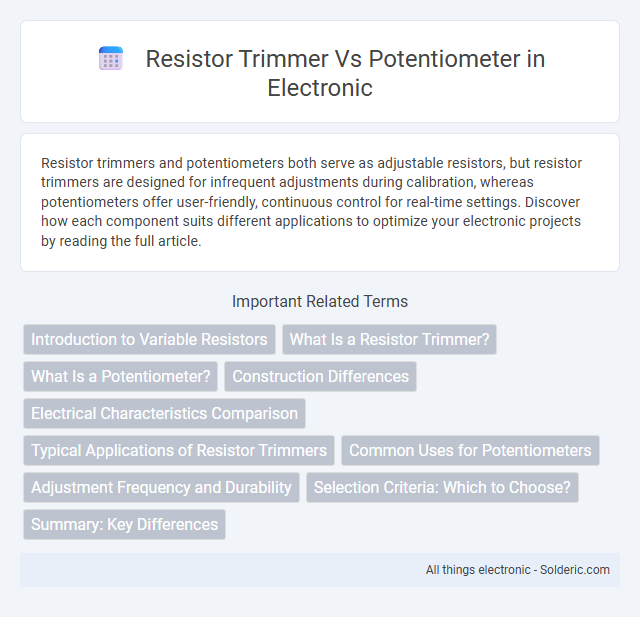Resistor trimmers and potentiometers both serve as adjustable resistors, but resistor trimmers are designed for infrequent adjustments during calibration, whereas potentiometers offer user-friendly, continuous control for real-time settings. Discover how each component suits different applications to optimize your electronic projects by reading the full article.
Comparison Table
| Feature | Resistor Trimmer | Potentiometer |
|---|---|---|
| Function | Adjusts resistance in circuits; preset tuning | Variable resistor for user-controlled adjustment |
| Adjustment Type | Set once or infrequently; requires tool | Continuous adjustment; user-accessible knob or slider |
| Size | Small, compact design for PCB mounting | Larger, bulkier than trimmers |
| Applications | Calibration, circuit tuning, factory presets | Volume control, tuning, user interfaces |
| Cost | Generally cheaper | Relatively more expensive |
| Durability | High stability, less wear | More wear due to frequent adjustments |
Introduction to Variable Resistors
Variable resistors control electrical resistance in circuits, with resistor trimmers and potentiometers being common types. Resistor trimmers offer precise, adjustable resistance for fine-tuning during manufacturing or servicing, while potentiometers allow users to change resistance dynamically through a dial or slider. Understanding the differences helps you select the right component for applications requiring adjustable resistance.
What Is a Resistor Trimmer?
A resistor trimmer is a small adjustable resistor designed for fine-tuning circuit parameters during calibration or testing phases. Unlike a potentiometer, which is meant for frequent adjustments, a resistor trimmer is typically set once and left in place to ensure stable resistance values. Your choice between a resistor trimmer and potentiometer depends on whether you need permanent calibration or regular manual control.
What Is a Potentiometer?
A potentiometer is a three-terminal variable resistor commonly used to adjust voltage levels by sliding a wiper across a resistive element. It functions as an adjustable voltage divider, allowing precise control over signal levels in circuits such as audio volume controls or sensor adjustments. Unlike fixed resistors, potentiometers provide continuous resistance variation, enabling fine-tuning within electronic devices.
Construction Differences
Resistor trimmers typically feature a compact, multi-turn screw adjustment mechanism embedded on a ceramic or plastic base, designed for precise, infrequent calibration. Potentiometers have a rotatable wiper sliding over a resistive track, housed in various forms such as rotary or linear, and enable continuous manual adjustment. The primary construction difference lies in the trimmer's fixed multi-turn design for fine tuning versus the potentiometer's user-friendly, easily accessible variable resistance control.
Electrical Characteristics Comparison
Resistor trimmers and potentiometers differ significantly in electrical characteristics; resistor trimmers typically offer lower power ratings and are designed for fine-tuning resistance within circuits, providing stable and precise adjustments with minimal wiper noise. Potentiometers, on the other hand, are built for continuous manual adjustment with higher power handling capabilities and can vary resistance over a wider range, making them suitable for user-controlled applications. Your choice depends on whether precise calibration or dynamic control is needed in your electronic design.
Typical Applications of Resistor Trimmers
Resistor trimmers are commonly used in precision calibration tasks such as adjusting circuit parameters in analog circuits, fine-tuning sensor outputs, and setting reference voltages in power supplies. Their compact size and stability under temperature variations make them ideal for applications requiring reliable, one-time or infrequent adjustments. Your electronic designs benefit from resistor trimmers when precise resistance tuning is essential to optimize performance and maintain long-term reliability.
Common Uses for Potentiometers
Potentiometers are commonly used for adjusting voltage levels in circuits, volume control in audio devices, and tuning signal inputs in sensors and instrumentation. They serve as variable resistors to fine-tune device performance or calibrate electronic components. Unlike trimmer resistors, potentiometers are designed for frequent manual adjustment during normal operation.
Adjustment Frequency and Durability
Resistor trimmers are designed for infrequent adjustments and provide long-term stability with minimal wear, making them ideal for calibration settings that rarely change. Potentiometers support frequent manual adjustments with a higher tolerance for mechanical stress, but this increased use can reduce their durability over time. The choice between the two depends on whether the application demands occasional precise tuning or constant user interaction.
Selection Criteria: Which to Choose?
When choosing between a resistor trimmer and a potentiometer, consider precision and adjustability requirements; resistor trimmers offer fine-tuning for calibration in circuit boards, whereas potentiometers provide easy manual adjustment. For applications requiring occasional tuning or user interface control, potentiometers are more suitable due to their accessible knobs. In contrast, resistor trimmers excel in permanent or semi-permanent settings where stability and minimal adjustment are critical.
Summary: Key Differences
Resistor trimmers are precise, compact adjustable resistors designed for calibration and fine-tuning in circuits, whereas potentiometers provide user-friendly variable resistance for manual control. Key differences include trimmers' limited adjustment range and fixed mounting options, contrasting with potentiometers' broader range and ease of rotation or sliding. Your choice depends on whether you need a stable, set-it-once resistor or an adjustable control interface.
Resistor trimmer vs potentiometer Infographic

 solderic.com
solderic.com